Element contents
Computational Fluid Dynamics and its Applications in Echinoderm Palaeobiology
Published online by Cambridge University Press: 30 October 2020
Summary
- Type
- Element
- Information
- Series: Elements of PaleontologyOnline ISBN: 9781108893473Publisher: Cambridge University PressPrint publication: 19 November 2020
References
- 11
- Cited by



